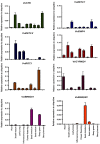Characterization of Endogenous Levels of Brassinosteroids and Related Genes in Grapevines
- PMID: 35163750
- PMCID: PMC8836857
- DOI: 10.3390/ijms23031827
Characterization of Endogenous Levels of Brassinosteroids and Related Genes in Grapevines
Abstract
Agronomic breeding practices for grapevines (Vitis vinifera L.) include the application of growth regulators in the field. Brassinosteroids (BRs) are a family of sterol-derived plant hormones that regulate several physiological processes and responses to biotic and abiotic stress. In grapevine berries, the production of biologically active BRs, castasterone and 6-deoxocastasterone, has been reported. In this work, key BR genes were identified, and their expression profiles were determined in grapevine. Bioinformatic homology analyses of the Arabidopsis genome found 14 genes associated with biosynthetic, perception and signaling pathways, suggesting a partial conservation of these pathways between the two species. The tissue- and development-specific expression profiles of these genes were determined by qRT-PCR in nine different grapevine tissues. Using UHPLC-MS/MS, 10 different BR compounds were pinpointed and quantified in 20 different tissues, each presenting specific accumulation patterns. Although, in general, the expression profile of the biosynthesis pathway genes of BRs did not directly correlate with the accumulation of metabolites, this could reflect the complexity of the BR biosynthesis pathway and its regulation. The development of this work thus generates a contribution to our knowledge about the presence, and diversity of BRs in grapevines.
Keywords: UHPLC-MS/MS; brassinosteroids; development; grapevine.
Conflict of interest statement
The authors declare no conflict of interest.
Figures




Similar articles
-
Grapevine CYP734A15 is a brassinosteroid-inactivating cytochrome P450 enzyme.Biochem Biophys Res Commun. 2025 Aug 15;775:152128. doi: 10.1016/j.bbrc.2025.152128. Epub 2025 May 31. Biochem Biophys Res Commun. 2025. PMID: 40472807
-
Arabidopsis PIZZA has the capacity to acylate brassinosteroids.PLoS One. 2012;7(10):e46805. doi: 10.1371/journal.pone.0046805. Epub 2012 Oct 5. PLoS One. 2012. PMID: 23071642 Free PMC article.
-
Brassinosteroids regulate plant growth through distinct signaling pathways in Selaginella and Arabidopsis.PLoS One. 2013 Dec 13;8(12):e81938. doi: 10.1371/journal.pone.0081938. eCollection 2013. PLoS One. 2013. PMID: 24349155 Free PMC article.
-
Brassinosteroids: Multidimensional Regulators of Plant Growth, Development, and Stress Responses.Plant Cell. 2020 Feb;32(2):295-318. doi: 10.1105/tpc.19.00335. Epub 2019 Nov 27. Plant Cell. 2020. PMID: 31776234 Free PMC article. Review.
-
Exploring the Brassinosteroid Signaling in Monocots Reveals Novel Components of the Pathway and Implications for Plant Breeding.Int J Mol Sci. 2020 Jan 5;21(1):354. doi: 10.3390/ijms21010354. Int J Mol Sci. 2020. PMID: 31948086 Free PMC article. Review.
Cited by
-
In-Silico Study of Brassinosteroid Signaling Genes in Rice Provides Insight Into Mechanisms Which Regulate Their Expression.Front Genet. 2022 Jul 6;13:953458. doi: 10.3389/fgene.2022.953458. eCollection 2022. Front Genet. 2022. PMID: 35873468 Free PMC article.
-
Contents of endogenous brassinosteroids and the response to drought and/or exogenously applied 24-epibrassinolide in two different maize leaves.Front Plant Sci. 2023 Jun 2;14:1139162. doi: 10.3389/fpls.2023.1139162. eCollection 2023. Front Plant Sci. 2023. PMID: 37332698 Free PMC article.
-
VaMIEL1-mediated ubiquitination of VaMYB4a orchestrates cold tolerance through integrated transcriptional and oxidative stress pathways in grapevine.Hortic Res. 2025 Mar 22;12(7):uhaf093. doi: 10.1093/hr/uhaf093. eCollection 2025 Jul. Hortic Res. 2025. PMID: 40391385 Free PMC article.
References
-
- Gladstone E.A., Dokoozlian N.K. Influence of leaf area density and trellis/training system on the light microclimate within grapevine canopies. Vitis. 2003;42:123–131.
-
- Keller M. The Science of Grapevines: Anatomy and Physiology. 2nd ed. Elsevier; Amsterdam, The Netherlands: 2015. pp. 1–101.
MeSH terms
Substances
Grants and funding
LinkOut - more resources
Full Text Sources

